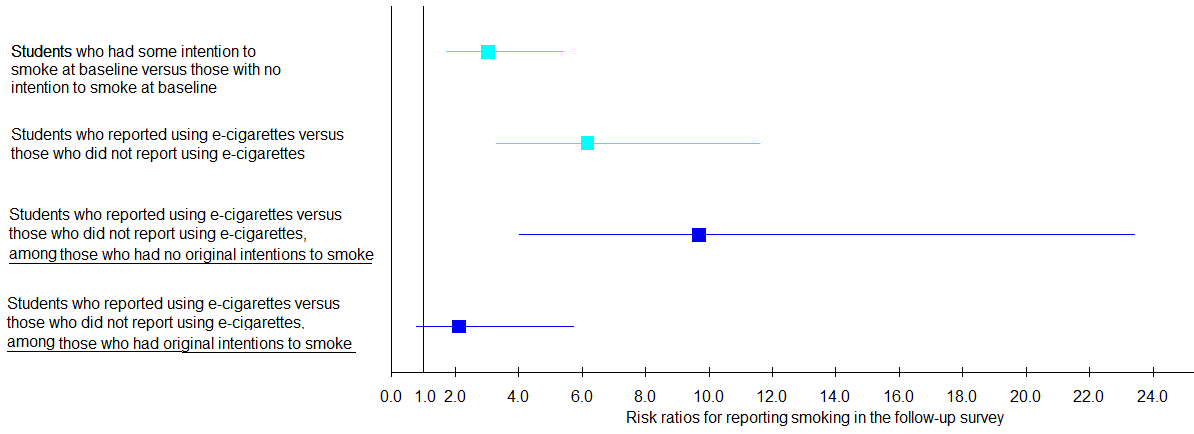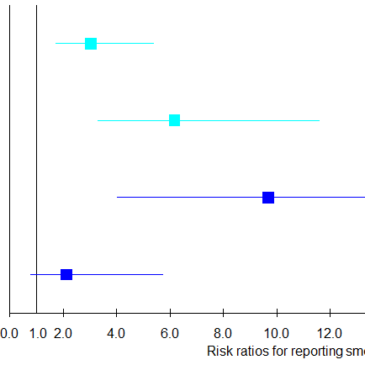Since e-cigarettes first appeared on the market roughly a decade ago, more and more teens have been using them. However, we still don’t know whether people who use e-cigarettes go on to smoke real cigarettes. This week, ASHES reviews a longitudinal study by Jessica Barrington-Trimis and colleagues that surveyed high school students and tracked e-cigarette use in high school and traditional smoking in early adulthood.
What is the research question?
Are adolescents who use e-cigarettes more likely to use smoke later in life? Does it depend on their initial intentions to smoke?
What did the researchers do?
Barrington-Trimis and her colleagues drew potential participants from the 11th and 12th graders who had completed the initial evaluation of the Southern California Children’s Health Study in 2014. Based on baseline data, they classified students into two e-cigarette groups: those who reported using e-cigarettes but never using traditional cigarettes (i.e., e-cigarette users), and those who reported never using e-cigarettes or traditional cigarettes (i.e., non-users).[1] They also classified students based on their initial intentions to smoke (i.e., those who definitely did not intend to smoke, versus everyone else). In early 2016, roughly 16 months after the initial evaluation, they asked these students to complete a follow-up survey and report any traditional smoking since the first evaluation.[2] They then used logistic regression to determine whether students who were e-cigarette users were at baseline were more likely to smoke during the time between the two surveys than non-users.
What did they find?
Overall, e-cigarette users had 6.17 times the odds of starting smoking later on as non-users (Figure). But baseline intentions to smoke played an important role. Among students who had future intentions to smoke, e-cigarette use at baseline did not predict future smoking. However, among students who did not have future intentions to smoke, those who reported using e-cigarettes at baseline were significantly more likely to smoke later on.
 Figure. Risk ratios (boxes) and confidence intervals (lines) for the use of traditional cigarettes. Their analysis took into account gender, ethnicity, grade, and parental education. Adapted from Barrington-Trimis et al. (2016). Click image to enlarge.
Figure. Risk ratios (boxes) and confidence intervals (lines) for the use of traditional cigarettes. Their analysis took into account gender, ethnicity, grade, and parental education. Adapted from Barrington-Trimis et al. (2016). Click image to enlarge.
Why do these findings matter?
Advocates often claim that e-cigarettes are a way to quit smoking. However, studies like this one suggest that they might also increase risk for non-smokers who have not yet considered smoking. The two phenomena are not mutually exclusive. The availability of e-cigarettes might have positive effects for some people and negative effects for others. In this study, for those who were already considering smoking, e-cigarette use had no significant effect on whether or not they tried smoking later.
Recently, Surgeon General Vivek H. Murthy published a report on e-cigarette use and its potential health risks. In the introduction, he notes that “e-cigarette use among youth and young adults has become a health concern.” Part of this concern might be that e-cigarettes are introducing smoking to young people who otherwise would not consider it. Researchers and public health officials should explore what factors distinguish e-cigarette users who stay with e-cigarettes or quit from e-cigarette users who transition to smoking.
Every study has limitations. What about this one?
The time for follow-up was fairly short – under two years. For many participants, this means that the study did not cover the participants’ first years of college or first entry-level jobs. Many people have less parental supervision and/or more disposable income than before. Young people may feel freer to experiment with products and activities that they might not have during their high school years.
For more information:
This webpage has most of the bullet points from the Surgeon General’s report on e-cigarette use. The full report can be found here. Your First Step to Change: Smoking is an online resource for those who are concerned about their smoking. For additional tools, please visit the BASIS Addiction Resources page.
— Matthew Tom
What do you think? Please use the comment link below to provide feedback on this article.
________________
[1] The non-users were matched with users on gender, ethnicity, and grade (11th or 12th).
[2] They attempted to recruit 213 students from each e-cigarette group into the follow-up. 146 of the e-cigarette users completed the follow-up, and 152 of the non-users completed the follow-up.




